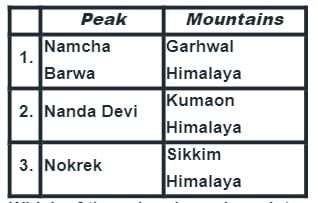Physiographic Divisions of India - Bank Exams MCQ
21 Questions MCQ Test - Physiographic Divisions of India
Consider the following statements regarding the Himalayas.
1. The Himalayas play a very significant role in influencing the climate of India.
2. The Himalayas are not appropriate for tourism activities.
3. The Himalayan Mountain system is the source of many rivers.
4. The Himalayas do not contain any minerals.
Which of the statements given above is/are correct?
Consider the following statements:
1. The Himalayas form an arc that covers a distance of about 2,400 km from Jammu & Kashmir in the west to Arunachal Pradesh in the east.
2. The width of the Himalayas varies from 400 km in Kashmir to 150 km in Arunachal Pradesh.
3. The Great Himalayas are composed mostly of sedimentary rocks.
Which of the statements given above is/are correct?
Consider the following statements:
1. The Himalayas are considered one of the 'newest fold mountains' of the world.
2. The Himalayas came up during the Tertiary epoch under Alpine earth movement.
3. The altitudinal variations are greater in the western half of the Himalayas than in the eastern half.
Which of the statements given above is/are correct?
Consider the following statements:
1. The Great Himalayan Range is characterized by asymmetrical folds.
2. The highest peak of the Great Himalayan Range is Mount Everest.
3. The Shiwalik Range is also known as the Inner Himalayan Range.
Which of the statements given above is/are correct?
Consider the following pairs regarding the ranges of the Lesser Himalayas:
1. Pir Panjal - Starts from near PatniTop in Jammu and Kashmir and passes through Himachal Pradesh
2. Dhauladhar - Begins from near Dalhousie and passes through the Beas River in Kullu
3. Nag Tibba - Located in Uttarakhand and marked by the Mussoorie range
4. Siachen Glacier - Located in the Lesser Himalayas
How many pairs given above are correctly matched?
Consider the following pairs regarding the physiographic divisions of the Himalayas:
1. Punjab Himalayas - Between Indus and Sutlej rivers
2. Kumaun Himalayas - Between Sutlej and Kali rivers
3. Central Himalayas - Between Kali and Teesta rivers
4. Assam Himalayas - Between Teesta and Brahmaputra rivers
How many pairs given above are correctly matched?
Consider the following pairs regarding the characteristics of the Himalayas:
1. Lesser Himalayas - Average height of 3500-5000 m
2. Shiwaliks - Made of clay, sand, gravel, slate, and boulders
3. Doon Valleys - Located in the Shiwaliks
4. Mount Everest - Located in the Shiwaliks
How many pairs given above are correctly matched?
Consider the following statements:
Statement-I:
The Kashmir/Punjab/Himachal Himalayas lie between the Indus and Satluj rivers and are characterized by high snow-covered peaks, deep valleys, interlocked spurs, and High Mountain passes.
Statement-II:
The Kumaun Himalayas are drained by the Indus and Ganga river systems and are distinguished by the 'DUN' formations like the Chandigarh-Kalka dun and Dehradun.
Which one of the following is correct in respect of the above statements?
Comparison between Northern and Southern slopes of Himalayas:
Statement I: Southern Slopes receive more precipitation as compared to Northern Slopes as it lies in the rain shadow region.
Statement II: Southern Slopes are covered with thick vegetation whereas Northern Slopes are generally barren.
Which one of the following is correct in respect of the above statements?
Consider the following statements:
Statement-I:
The Central/Nepal Himalayas are known for their fast-flowing rivers like TEESTA and their Tea plantations due to good rainfall all year and mild winters.
Statement-II:
The major ranges in the Himalayas include Karakoram, Ladakh, Pir Panjal, Zanskar, and Dhauladhar.
Which one of the following is correct in respect of the above statements?
Which region in the Himalayas is known for the presence of the "valley of flowers"?
Which pass is NOT mentioned as an important pass in the Eastern Himalayas/The Assam Himalayas region?
The Bhutias, who migrate to the "Bugyals," inhabit which region of the Himalayas?
Consider the following statements:
1. Karewa soil is found predominantly in the Himachal Himalayas.
2. Karewa soil is known for the cultivation of saffron and other dry fruits.
3. The snowline in the Eastern Himalayas is at a higher altitude than in the Western Himalayas.
Which of the statements given above is/are correct?
Consider the following statements:
1. The Siachen Glacier is located in the Karakoram Range.
2. The Pindari Glacier is part of the Kumaon-Garhwal Range.
3. The term "glacier" originates from the German word for ice.
Which of the statements given above is/are correct?
Consider the following statements:
1. The snowline is a boundary between a snow-covered and snow-free surface.
2. The snowline in the Western Himalayas is at a higher altitude than in the Eastern Himalayas.
3. The Satopanth Glacier is located in the Pir Panjal Range.
Which of the statements given above is/are correct?
Consider the following pairs regarding mountain peaks:
1. Nanga Parbat - Western Himalayas
2. Annapurna - Eastern Himalayas
3. Mount Everest - Nepal Himalayas
4. Mount K2 - Karakoram Range
How many pairs given above are correctly matched?
Consider the following pairs regarding mountain passes:
1. Rohtang Pass - Himachal Pradesh
2. Nathu La - Sikkim
3. Zoji La - Uttarakhand
4. Thalghat - Maharashtra
How many pairs given above are correctly matched?
Consider the following pairs regarding the physiographic divisions of the Himalayas:
1. Trans-Himalayas - Ladakh
2. Greater Himalayas - Sikkim
3. Lesser Himalayas - Himachal Pradesh
4. Shiwaliks - Assam
How many pairs given above are correctly matched?
Consider the following pairs:

Which of the pairs given above is/are correct?
Comparison between Western Himalayas and Eastern Himalayas:
Statement I: Western Himalayas extend till west of River Kali whereas Eastern Himalayas extend from Kali to the Brahmaputra river.
Statement II: Western Himalayas have less biodiversity in comparison to eastern Himalayas.
Which one of the following is correct in respect of the above statements?














